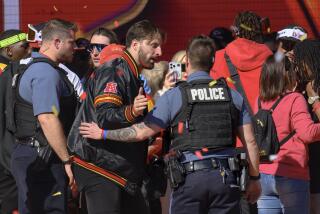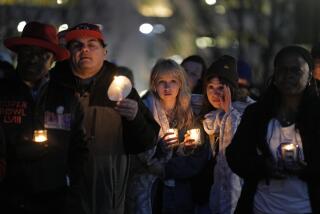Protesters and police face off in St. Louis suburb over shooting
Reporting from Ferguson, Mo. — The protesters, almost all of them black, raised their fists and chanted, “We shall not be moved!”
Down the hill, advancing against them late Monday night, were police officers in gas masks and riot gear, most of them white.
“Don’t shoot!” some of the demonstrators yelled, inching closer to the barely visible police line. One man drifted several dozen feet closer with his arms up, lifting his shirt and spinning around as if to say: Look, no gun.
Then an older woman in a dust mask to shield her a bit from the swirling tear gas spotted him and shouted, “Get your ass back here!”
The two sides were locked in confrontation in this working-class suburb of St. Louis, where the police shooting of an unarmed young black man triggered a night of looting Sunday — and demands for justice from a predominantly black population.
The nighttime standoff and billowing tear gas on West Florissant Avenue reflected simmering racial tensions in Ferguson, population 21,000, where two-thirds of residents are black but police and city officials are predominantly white.
In a suburb abandoned by some whites as blacks moved in decades ago, the death Saturday of Michael Brown, 18, brought national attention to what many black residents say is a pattern of racial injustice here.
As the U.S. Justice Department announced an investigation in conjunction with a separate county police inquiry, black leaders called for nonviolence but accused local police and other officials of condoning racism in Ferguson and greater St. Louis for too long.
“In the greater picture, what we saw … was the boiling over of tensions that had been going on for a long while,” said Antonio French, a St. Louis city alderman who is black.
James Clark, vice president of a St. Louis nonprofit, Community Outreach for a Better Life, said the violence following Brown’s death was “due to a total alienation of a certain class of African Americans.”
Ferguson’s police chief and mayor are white. Of the six City Council members, one is black. The local school board has six white members and one Latino. Of the 53 commissioned officers on the police force, three are black, said Ferguson Police Chief Thomas Jackson.
Blacks in Ferguson are twice as likely to be stopped by police as whites, according to an annual report on racial profiling by the Missouri attorney general. Last year, 93% of arrests following car stops in Ferguson were of blacks. Ninety-two percent of searches and 80% of car stops involved blacks, the report said.
Brown was walking down a street with a friend Saturday when, according to police, an officer drove up and attempted to get out of his patrol car. Brown pushed the officer back into the car, then entered the vehicle as the two men struggled over the officer’s gun, according to Jon Belmar, chief of the St. Louis County Police Department.
During the altercation a shot was fired inside the car, Belmar said. The officer and Brown then got out of the car, and at that point the fatal shooting occurred, Belmar said. Brown was shot “more than just a couple of times,” but it was unclear how many shots were fired, Belmar said.
Witnesses challenged the police version of events. One resident, Piaget Crenshaw, said Brown “ran for his life.”
“They shot him and he fell,” Crenshaw said. “He put his arms up to let them know that he was compliant and he was unarmed, and they shot him twice more and he fell to the ground and died.”
Ferguson Mayor James Knowles pledged in a televised interview that “justice will be served” and called on the people of Ferguson to “have faith in the process.”
Belmar told reporters: “I understand that the public has a right to be skeptical … but I would also ask the public to be reasonable because it takes a long time to make sure we do this investigation the right way.”
At the police station Monday morning, protesters said they wanted the police officer identified, fired and charged in the killing. They also demanded that the Ferguson police force reflect the racial demographic of the community. The demonstrators raised their hands in mock surrender, chanting: “Hands up! Don’t shoot!”
“People are angry, people are hurt, people are fed up,” said one protester, Derek Laney, 49, of St. Louis.
Jerryl Christmas, 50, a defense attorney and former prosecutor for the city of St. Louis, watched from the sidewalk Monday in a bright striped tie, holding a small bullhorn.
“Look out here right now,” Christmas said, gesturing to the line of white police officers. “The lack of black police officers either on the street or at the administrative level…. This whole area, this city is a racial powder keg.”
As riot police squeezed protesters farther down the street Monday morning, Jackson, the city’s police chief, stood, sunburned and sweating, in the shade of a billboard across from the police station. He said he was shot at three times outside Wal-Mart during Sunday night’s riots.
He said about 12 businesses were damaged by a crowd that smashed windows, looted stores and set a fire inside a mini-mart. Some chanted: “No justice! No peace!”
Police arrested 32 people for looting. Several police officers were slightly injured.
Jackson said he planned to identify the suspended officer involved in Brown’s shooting after he contacted him — in case the officer wanted to go elsewhere for his own safety.
Police arrested seven people during Monday’s demonstration in the morning, Jackson said. “We want them to be able to protest,” he said. But after peaceful protesters left, they were replaced by angry demonstrators “not so much interested in peaceful resolution,” Jackson said.
As Brown’s parents wiped away tears at a news conference in Ferguson, their lawyer, Benjamin Crump, told reporters: “I don’t want to sugarcoat. That brother was executed in broad daylight.”
Crump, who also represented the parents of slain Florida teen Trayvon Martin, said the Brown family and many other Ferguson residents didn’t trust the police or local authorities.
“They are devastated that this happens again and again and it’s swept under the rug again and again,” Crump said. “Not this time.”
Brown’s parents said they had planned to drop off their son to begin community college on Monday. Instead, they were planning his funeral.
Lesley McSpadden, Brown’s mother, wept as she held up a photo of her son. “We are going to do this right,” she said. “We don’t want no violence because Michael wouldn’t have wanted violence.”
Michael’s father, Michael Brown Sr., repeated three times: “We need justice for our son.”
Earlier Monday, a school district adjacent to Ferguson canceled the first day of school, saying it was concerned for student safety following Sunday night’s violence.
On Monday afternoon, the sound of hammers could be heard for more than a mile up and down West Florissant Avenue, where looters had smashed windows at fast-food restaurants, auto shops and other buildings the night before.
Workers hustled to replace Zisser Tire’s windows with plywood. Thieves had stolen tire rims from the showroom; video captured one thief using a rim to smash out each of the windows.
Dennis G. Ferguson, a salesman for the store, said he had called the owner the night before and debated bringing in rifles as looters worked their way down the street. Ultimately, he decided against it.
Ferguson insisted that the looting did not reflect the neighborhood.
“This is a nice community,” he said, recounting that residents had helped protect businesses overnight. “We had several teenagers come by to see if they could help clean up.”
Pearce reported from Ferguson, Mo., Srikrishnan from Los Angeles and Zucchino from North Carolina.
More to Read
Sign up for Essential California
The most important California stories and recommendations in your inbox every morning.
You may occasionally receive promotional content from the Los Angeles Times.












